Get Tech Tips
Subscribe to free tech tips.
Manual D Speedsheet Walkthrough
Bryan recently released a podcast on rules of thumb and how they can really get us in a pickle with sizing ductwork. With that in mind, I thought this might be a good time to do a walkthrough of Manual D from start to finish on a project I just finished up.
My good friend is remodeling a portion of his house and asked me to do the HVAC design work. It was my first time walking through the whole design process from start to finish. For this article, I wanted to focus on just the duct design, but you have to start with Manual J.
First, I did a load calculation based on the 2018 building code because those are the standards he is building to. The space is about 600 square feet and calls for about ¾ of a ton of cooling.
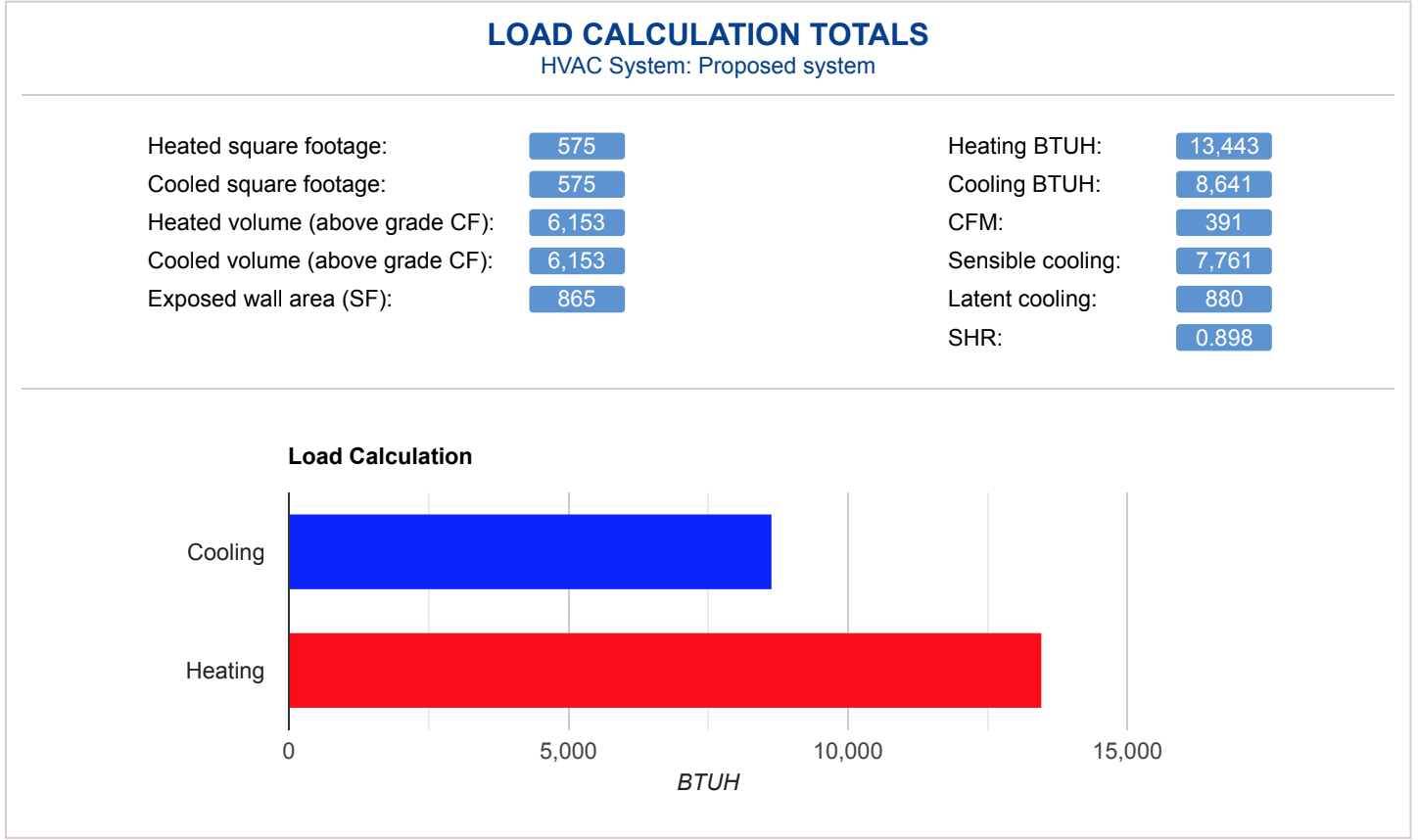
Then, I selected a piece of equipment that matched the heating and cooling requirements with Manual S. Once I did that, I could begin my duct design. The unit I picked was a ducted mini split that only had an available static pressure of 0.2″WC. I had to pick this unit because there weren’t very many options that would work for a system that had such small heating and cooling loads. Many manufacturers' smallest units start at 1.5 tons.
Once we have our available static pressure, we can start working on the actual Manual D process. The first thing we need to do is subtract our various component pressure drops. An acceptable method in Manual D is to use a 0.03″WC pressure drop for dampers, supply registers, and return grilles. That said, if you are able to select the exact model of registers and grilles, it is recommended that you use the pressure drop in the manufacturer's performance data. However, because I knew I didn’t have much static pressure to work with, I chose an AprilAire filter back return that includes the return grille and the filter pressure drop together. I looked at the total CFM that would be moving through the filter on my unit (388 on high fan speed, according to the manufacturer’s data) and compared it to the chart below. If I use a MERV 11 filter, I will have a 0.03″WC pressure drop.

What other components do I need to factor in? Well, if I were installing a furnace, I would've had to subtract the coil pressure drop. You may need heat strips if the heat pump you install doesn’t have enough capacity at design conditions, but this ducted mini split had enough capacity. We figure that out during the Manual S design phase where you calculate thermal balance point, meaning you determine if it needs heat strips to help maintain the heating load at design conditions.
Besides my damper (0.03″WC), my supply grille (0.03″WC), and my filter and return grille (0.03″WC), I didn’t have any other components to subtract. The static pressure in the manufacturer's performance data was 0.2″WC, and I subtracted 0.09″WC, leaving me 0.11″WC available static pressure. Here is the filled-out speed sheet that you can get for free from ACCA:

The final piece of data you need is to determine the total effective length of your longest duct run. The “longest duct run” may not actually be the duct that runs the furthest; every component, like a 90, wye, or boot, has a total effective length (TEL). There is a chart for this as well that allows you to calculate each run to see which is the longest.
I didn't end up using the chart because my duct system was very small, and both of my longer supply runs were almost identical. My longest run is the one that goes over the table in the middle of the game room. You can look up the TEL for each type of fitting in the charts on the Excel sheet attached to the ACCA speed sheet, or you can look in a physical copy of Manual D for the same charts.
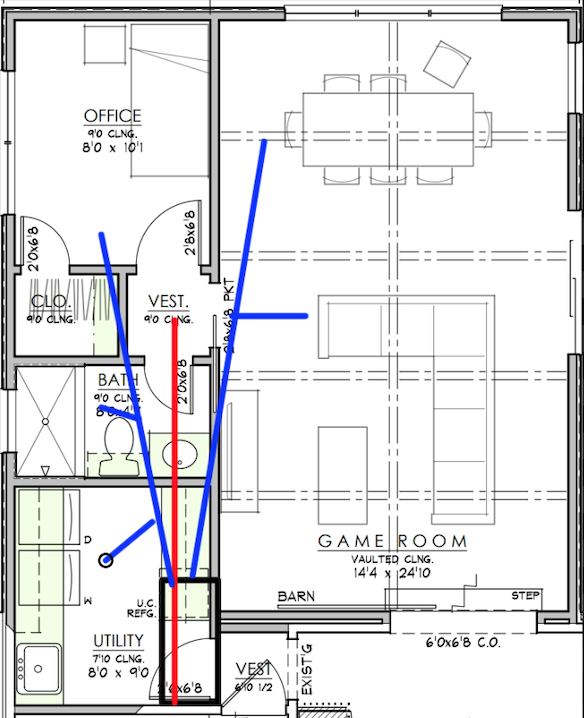
The transition from plenum to collar has a TEL. I decided to use fitting 1A on the left for 35 feet of EL.
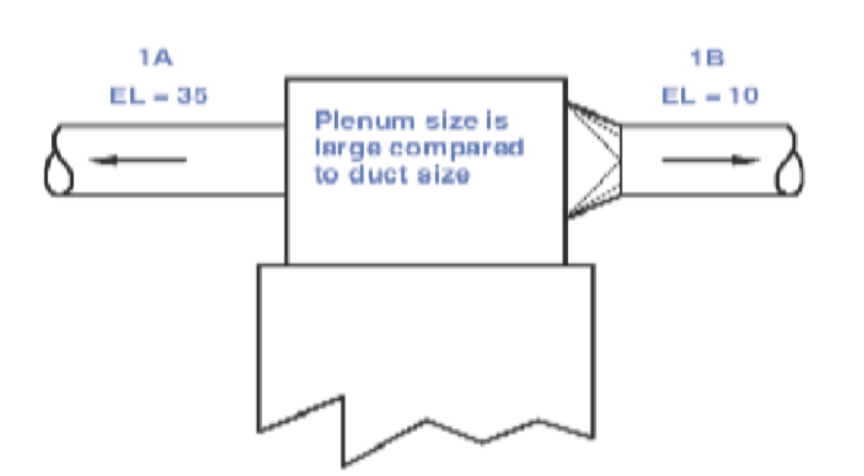
Then, I’m going to use a 4-piece 90 to turn. So, that is 20 feet.
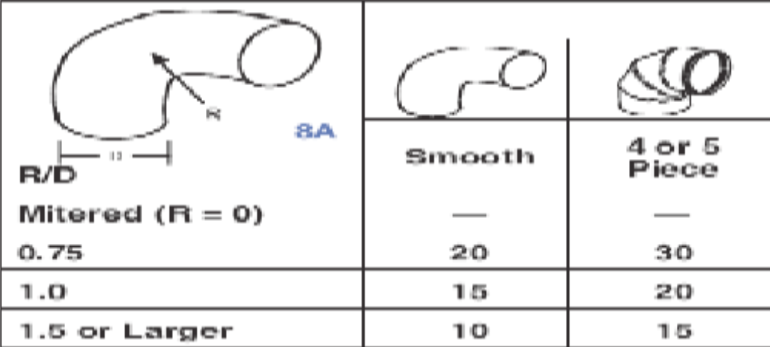
Now, I have about 12 feet of straight duct. Then, I have a wye that I have to use the “branch” on because that is going to make it the longest run. So, that's 25 feet.
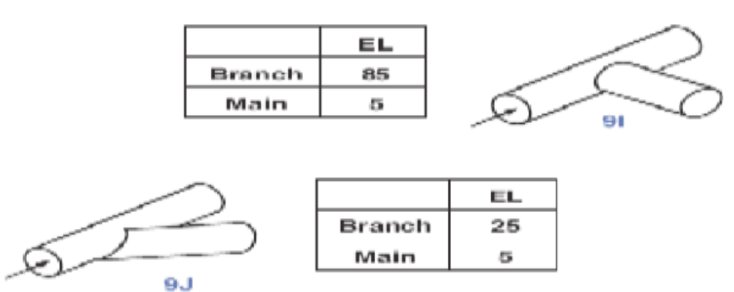
Following that is 8 feet of straight duct and then my boot. I’m going to pick the one that is only 10 feet of EL. I also need to add another 90 to turn into the boot. So, that's another 20 feet.
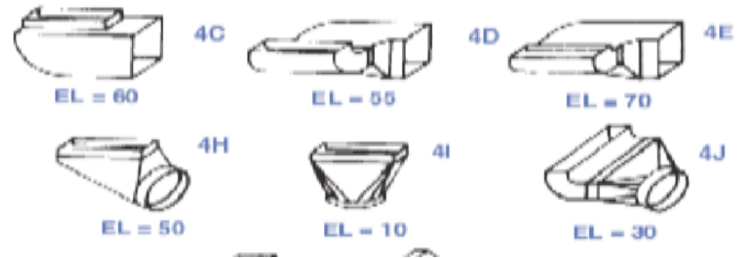
So far, the supply side TEL is: 35 + 20 + 12 + 25 + 8 + 10 + 20 = 130 feet
Now let’s do the return side, which actually has separate ELs for some of the fittings than the supply side. I’ll work from the filter back to the return plenum. The back of my return filter will have a 90 like this, which is 20 ft.

Then, I have 20 feet of straight return duct and a transition back into the return plenum. So, that's 40 feet. I will also need a 90-turn, which is another 20 feet. I would love to deadhead into the back of the return plenum, but this thing is a ducted mini-split, so I wouldn’t have enough room on the end of the plenum; it will just be too skinny. Tapping straight onto the back of a plenum is only 10 feet of EL!
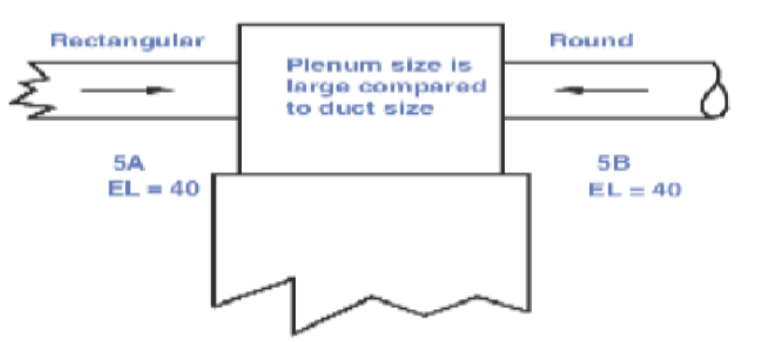
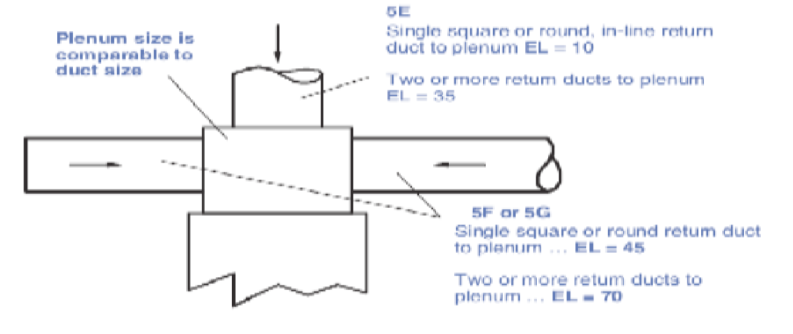
So, my entire return side TEL is: 20 + 20 + 40 + 20 = 100
I add my supply side (130) + return side (100) = 230
The spreadsheet does the math for you, but FR = ASP x 100 / TEL
So, for my job, it’s FR = 0.11 x 100 / 230, which comes out to 0.047. The spreadsheet rounds it to 0.05. This was a confusing part that threw me for a loop. According to the ACCA wedge, 0.05”WC is actually too low of a friction rate. The ACCA wedge is a chart in Manual D where you plot your calculated friction rate. ACCA recommends only using friction rates that plot within the wedge.
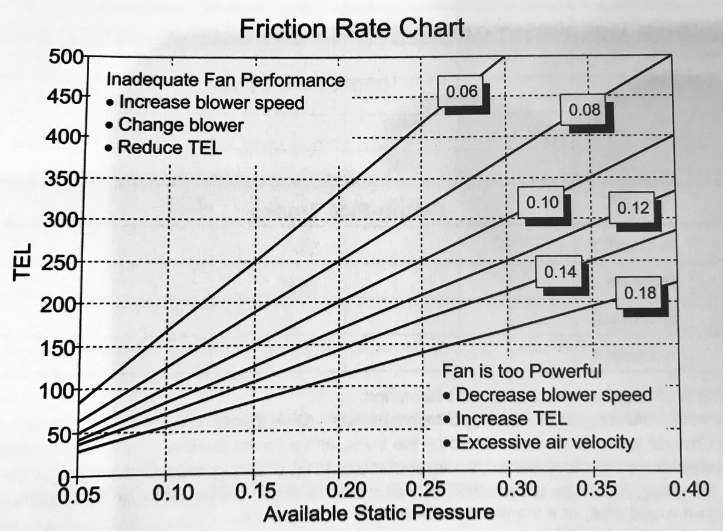
But when I looked at the ACCA speed sheet, 0.02”WC is the lowest available to use. A lower friction rate means a larger duct, and ACCA also says, “There are scores of things to worry about when designing and installing a comfort system. Low velocity through a duct airway is not one of them.” I also know that a bigger duct means lower velocity, so I decided to stick with the results of the speed sheet.

To size a duct for a specific room, I need to know how much air that room needs. That takes us back to Manual J. Here is the design CFM for the game room:

So, I need 200 CFM total in the room. Using my Ductulator, I can set up my friction rate of 0.05 across from my desired CFM and look at whatever style of duct I’m going to use (in this case, flex duct). According to the Ductulator, I need to use a 10-inch duct. I’m going to put two supplies in the room and have 100 CFM come out of each one, so using the Ductulator again, I end up with an 8-inch duct for each branch off of the wye.
For the return side, I can do the same thing again. I line up my friction rate across from my desired CFM (in this case, 400) and look at the flex duct size based on that. It shows I need a 14-inch duct. Sizing the ducts for the rest of the addition follows the same procedure.
—Matt Bruner
P.S. – You can learn more about residential system design at the ESCO Institute's HVACR Learning Network. Russ King led a webinar about system design that you can watch for FREE and get NATE credits when you finish. You can watch that webinar HERE.











Comments
Great points. and info. thank you.
Great points. and info. thank you.
Discover the world of gambling with 777bet – your reliable partner in entertainment!
With an impressive variety of games, 777bet meets the needs of different types of players.
Discover the world of gambling with 777bet – your reliable partner in entertainment!
With an impressive variety of games, 777bet meets the needs of different types of players.
Hello
https://zasvoih.ru/
Hello
https://zasvoih.ru/
Gaming has become more exciting than ever, and any enthusiast can find something unique. No matter what genre you love, the excitement of leveling up keeps players coming back.
With platforms like Playamo, gamers explore a wide variety of entertainment, reward systems that enhance the journey, and a community that grows every day. Dive in and experience the future of interactive fun today!
https://gyn101.com/
https://gyn101.com/
Gaming has become more exciting than ever, and any enthusiast can find something unique. No matter what genre you love, the excitement of leveling up keeps players coming back.
With platforms like Playamo, gamers explore a wide variety of entertainment, reward systems that enhance the journey, and a community that grows every day. Dive in and experience the future of interactive fun today!
https://gyn101.com/
https://gyn101.com/
TurkPaydexHub se demarque comme une plateforme de placement crypto de pointe, qui met a profit la puissance de l’intelligence artificielle pour offrir a ses utilisateurs des avantages decisifs sur le marche.
Son IA scrute les marches en temps reel, detecte les occasions interessantes et execute des strategies complexes avec une precision et une vitesse hors de portee des traders humains, optimisant ainsi les potentiels de profit.
TurkPaydexHub se demarque comme une plateforme de placement crypto de pointe, qui met a profit la puissance de l’intelligence artificielle pour offrir a ses utilisateurs des avantages decisifs sur le marche.
Son IA scrute les marches en temps reel, detecte les occasions interessantes et execute des strategies complexes avec une precision et une vitesse hors de portee des traders humains, optimisant ainsi les potentiels de profit.
TurkPaydexHub se demarque comme une plateforme d’investissement crypto revolutionnaire, qui exploite la puissance de l’intelligence artificielle pour fournir a ses clients des avantages decisifs sur le marche.
Son IA scrute les marches en temps reel, repere les opportunites et met en ?uvre des strategies complexes avec une finesse et une celerite inaccessibles aux traders humains, maximisant ainsi les potentiels de profit.
TurkPaydexHub se demarque comme une plateforme d’investissement crypto revolutionnaire, qui exploite la puissance de l’intelligence artificielle pour fournir a ses clients des avantages decisifs sur le marche.
Son IA scrute les marches en temps reel, repere les opportunites et met en ?uvre des strategies complexes avec une finesse et une celerite inaccessibles aux traders humains, maximisant ainsi les potentiels de profit.
Clarte Nexive se demarque comme une plateforme d’investissement en crypto-monnaies revolutionnaire, qui met a profit la puissance de l’intelligence artificielle pour proposer a ses membres des atouts competitifs majeurs.
Son IA scrute les marches en temps reel, repere les opportunites et applique des tactiques complexes avec une exactitude et une rapidite inatteignables pour les traders humains, augmentant de ce fait les perspectives de gain.
Clarte Nexive se demarque comme une plateforme d’investissement en crypto-monnaies revolutionnaire, qui met a profit la puissance de l’intelligence artificielle pour proposer a ses membres des atouts competitifs majeurs.
Son IA scrute les marches en temps reel, repere les opportunites et applique des tactiques complexes avec une exactitude et une rapidite inatteignables pour les traders humains, augmentant de ce fait les perspectives de gain.
https://moneylead.gg/
https://moneylead.gg/
Great points. and info. thank you.
Great points. and info. thank you.
How did this actually work out? You got a friction rate of 0.047, which is well under what manual D would suggest for this application. The speed sheet minimum values do not overrule the Manual D itself. Your blower does not seem to have enough static pressure for your longest run. Also, many states have code that dictate minimum duct velocities. Main trunks 700-900 min, branch ducts 600 min.
How did this actually work out? You got a friction rate of 0.047, which is well under what manual D would suggest for this application. The speed sheet minimum values do not overrule the Manual D itself. Your blower does not seem to have enough static pressure for your longest run. Also, many states have code that dictate minimum duct velocities. Main trunks 700-900 min, branch ducts 600 min.
To leave a comment, you need to log in.
Log In